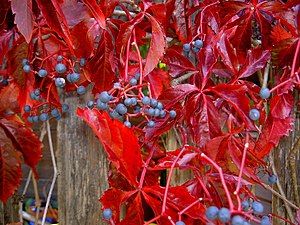Self-climbing virgin vine
| Self-climbing virgin vine | ||||||||||||
|---|---|---|---|---|---|---|---|---|---|---|---|---|

Wild grape in autumn colors with berries |
||||||||||||
| Systematics | ||||||||||||
|
||||||||||||
| Scientific name | ||||||||||||
| Parthenocissus quinquefolia | ||||||||||||
| ( L. ) Planch. |
The Parthenocissus quinquefolia ( Parthenocissus quinquefolia ), as well as the Parthenocissus tricuspidata ( Parthenocissus tricuspidata ) and the Common Woodbine ( parthenocissus Vitacea ) as a wild wine is designated, a species of the genus parthenocissus ( parthenocissus ) within the family of vine plants (Vitaceae). Their home is eastern North America.
description
The self-climbing virgin vine is a climbing plant that reaches heights of growth of 20 to 30 m. The tendrils are five to eight armed and have adhesive discs. Some varieties can only adhere to wall surfaces to a limited extent and are better suited for trellises. In contrast, the 'Engelmannii' variety has good climbing properties. The five-fingered leaves are whitish green and matt on the underside. The flowers blooming in June to July are inconspicuous and green-white. From September the pea-sized berries are black with a blue wax coating and birds like to eat them. In autumn the leaves turn from scarlet to purple. The self-climbing maiden vine likes nutrient-rich soil and thrives well in the shade and in the sun.
The number of chromosomes is 2n = 40.
use
Some varieties are used as ornamental plants because of their autumn colors .
The self-climbing virgin vine is one of the most uncomplicated climbing plants for large-scale facade and building greening . Once grown, it can initially be largely left to its own devices and can automatically overgrow multi-storey buildings within decades if enough light and water is available. In contrast to some creepers , the shoots do not wind around downpipes or other components. And in contrast to ivy , the shoots grow into cavities, but do not adhere to them and do not develop further if they do not find their way back into the light. The main shoots, like those of the grapevine, can almost reach the thickness of an arm after a few decades . Since they do not have the tendency to grow into crevices, there is usually no danger for facade cladding or building connections.
The adhesive discs stay on the ground when the plant is removed and are difficult to remove. As they are very small, they are usually only noticeable on very smooth and even surfaces.
The plant overgrows roof areas that do not heat up too much. This is usually the case on roof surfaces sloping to the north and east. This is not a fundamental problem as long as it is possible to occasionally remove shoots and leaves that in the long term impede the drainage of rainwater in the gutters.
Systematics
The first publication was in 1753 by Carl von Linné under the name ( Basionym ) Hedera quinquefolia in Species Plantarum , 1, p. 202. The new combination to Parthenocissus quinquefolia (L.) Planch. was published by Jules Émile Planchon . More synonyms of Parthenocissus quinquefolia (L.) Planch. are: Ampelopsis quinquefolia (L.) Michx. , Parthenocissus engelmannii Koehne & Graebn. , P. quinquefolia f. engelmannii (Koehne & Graebn.) Rehder , Psedera quinquefolia (L.) Greene , Quinaria hederacea Raf. nom. illegal. superfl., Vitis quinquefolia (L.) Lam.
The forms previously listed as varieties or subspecies are probably only varieties (selection forms).
photos
swell
- Zhiduan Chen & Jun Wen: Parthenocissus : Parthenocissus quinquefolia , p. 176 - the same text online as the printed work , In: Wu Zheng-yi, Peter H. Raven & Deyuan Hong (eds.): Flora of China , Volume 12 - Hippocastanaceae through Theaceae , Science Press and Missouri Botanical Garden Press, Beijing and St. Louis 2007. ISBN 978-1-930723-64-1 (systematics section)
Individual evidence
- ↑ Walter Erhardt among others: The great pikeperch. Encyclopedia of Plant Names . Volume 2. Verlag Eugen Ulmer, Stuttgart 2008. ISBN 978-3-8001-5406-7
- ↑ Dorothée Waechter: Lazy The Plants , BLV, ISBN 3-405-16486-9
- ^ Erich Oberdorfer : Plant-sociological excursion flora for Germany and neighboring areas . 8th edition. Verlag Eugen Ulmer, Stuttgart 2001, ISBN 3-8001-3131-5 . Page 654.
Web links
- Self-climbing virgin vine. In: FloraWeb.de.
- Distribution map for Germany. In: Floraweb .
- Parthenocissus quinquefolia (L.) Planch. In: Info Flora , the national data and information center for Swiss flora . Retrieved December 6, 2015.
- Thomas Meyer: Data sheet with identification key and photos at Flora-de: Flora von Deutschland (old name of the website: Flowers in Swabia )
- Facade green - wild wine five-leaved
- Parthenocissus quinquefolia (Photos)


